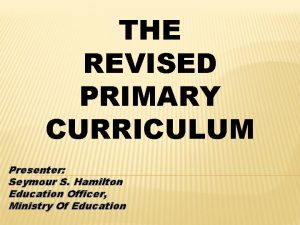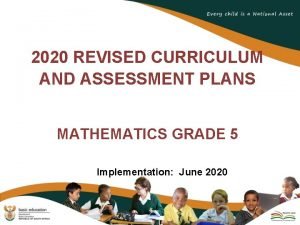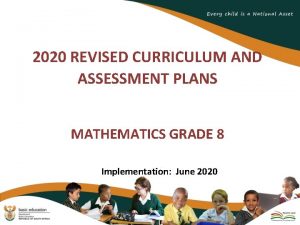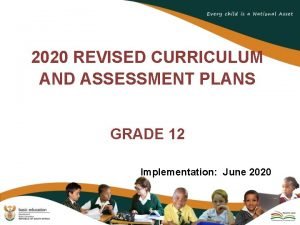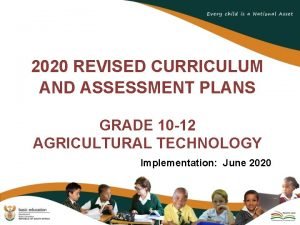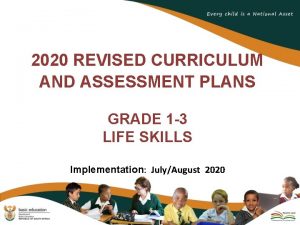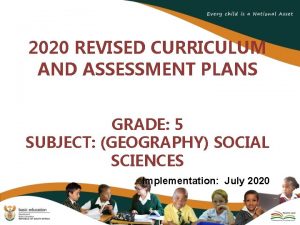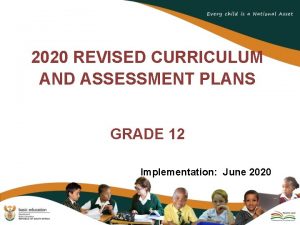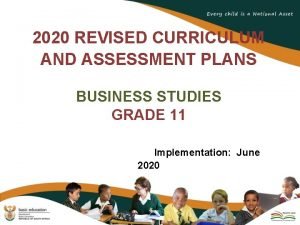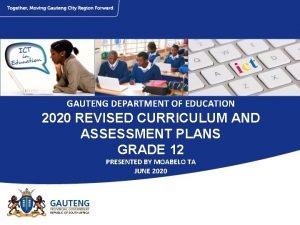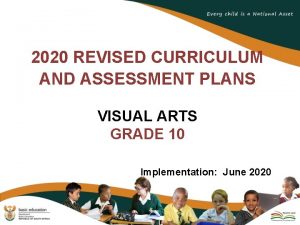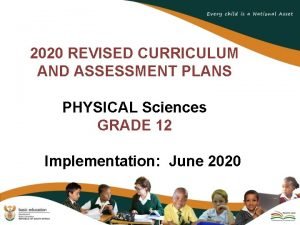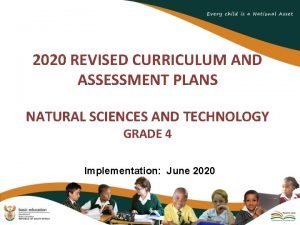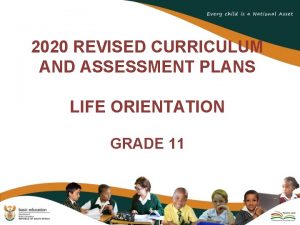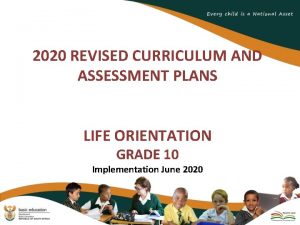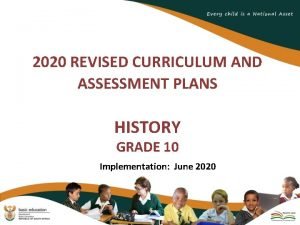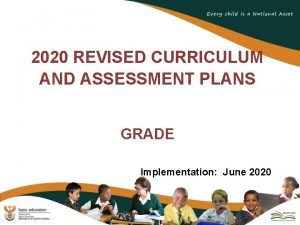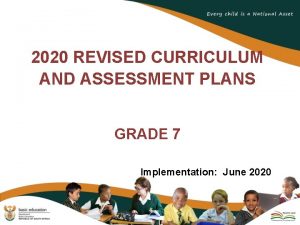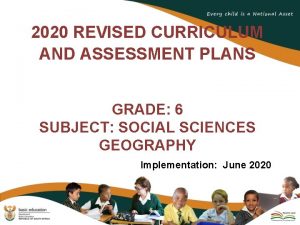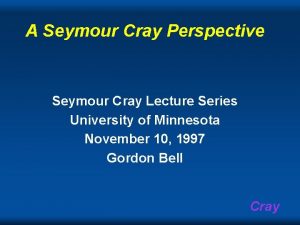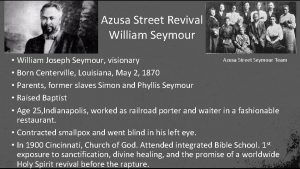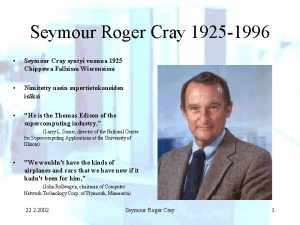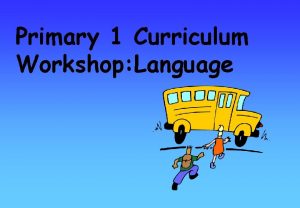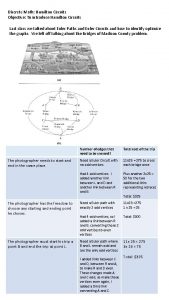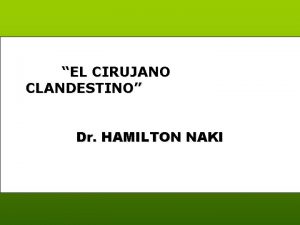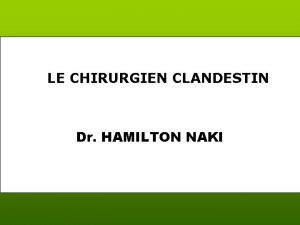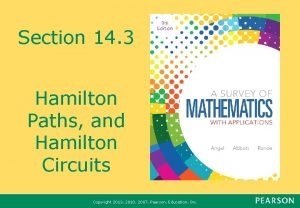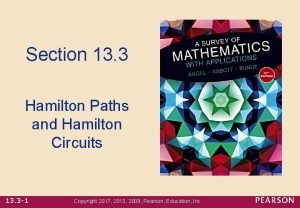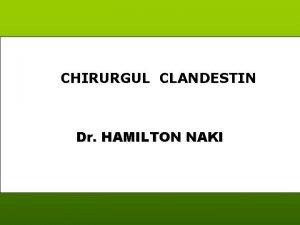THE REVISED PRIMARY CURRICULUM Presenter Seymour S Hamilton





















- Slides: 21

THE REVISED PRIMARY CURRICULUM Presenter: Seymour S. Hamilton Education Officer, Ministry Of Education

SESSION OBJECTIVES: For participants to: understand the structure of the Revised Primary Curriculum (RPC) Be able to break down a unit into teachable chunks

THE MODEL – (GRADES 1 – 3) Integrated Curriculum Mathematics Window Language Window

SCOPE & SEQUENCE – GRADES 1 TO 3 GRADE 1 GRADE 2 GRADE 3 THEME ALL ABOUT ME AND MY ENVIRONMENT SUB THEME M Y S E L F Unit 1 Unit 2 • • SUBTHEME Who Am I? My Body (i) MY HOME Unit 1 • My Family Unit 2 • Things in the Home ______ Unit 3 SUBTHEME Unit 1 Unit 2 Unit 3 • • MY FAMILY Myself At School • Together at School ______ • • • ________ • MY COMMUNITY My Body (iii) Satisfying Other Needs • Providers of Goods and Services Relating to Others outside Jamaica Aspects of the Jamaican Culture 2 MY PHYSICAL ENVIRONMENT • This is My Community • Places of Interest in My • Community Plants and Animals in My __________ Community • 1 MY COMMUNITY, THE NATION AND THE WIDER WORLD • Living Together as a Family • Satisfying Our Needs MY SCHOOL • My Body (ii) Care & Safety of Self TERM • Living and Non Living Things in My environment Caring For My environment 3

THE MODEL – (GRADES 4 – 6) Drama Social Studies Mathematics Language Arts Physical Education Visual Arts Science Religious Education Music Discrete Subjects with opportunities for some integration

BREAKING DOWN A UNIT 1. 2. 3. 4. P 52 Identify the number of focus questions in the unit (whether 2, 3 or 4) Identify the suggested time allocated for the unit (e. g. 3 or 4 weeks) Identify the objectives along with the suggested activities aligned to each focus question Determine for each focus question the length of time needed

BREAKING DOWN A UNIT 5. 6. – Allocate time for each focus question (e. g. focus question 1 …… 2 weeks focus question 2 ……… 1 week focus question 3 ……. 2 weeks Further break down each focus question allocated for more than a week into week 1 and week 2 etc. Further break down week 1 into smaller chunks – matching objectives and activities so that you have objectives and activities for day 1, day 2, day 3 etc.

THE GRADES 1 -3 MATHEMATICS WINDOW The Mathematics Window describes: The Mathematics Window in the curriculum refers to a particular session in grade 1, 2 or 3 which concentrates on numeracy. The Mathematics Window may be used to: introduce skills necessary for learning in a particular area of the integrated content. reinforce skills previously introduced through an integrated lesson. teach areas not included in the integrated content assess pupils’ learning

THE GRADES 1 -3 MATHEMATICS WINDOW The Mathematics Window describes: The interest and enjoyment that should be experienced in learning in the integrated content and should be maintained in this Window. The Mathematics Window should be used every day for periods not exceeding sixty (60) minutes. The teacher may ‘open’ this Window at any time of the day he / she chooses, although most schools prefer to have the Window periods scheduled on a weekly timetable.

‘HOW TO USE THESE UNITS’ AND ‘THE PHILOSOPHY BEHIND THE CURRICULUM’ To be found in the Curriculum Guides on pages: 50 – 51 of the Grade 4 43 – 44 of the Grade 5 47 – 48 of the Grade 6 Participants need to read these sections so as to familiarise themselves with what is expected of them as they teach the Units. These sections also give: the number of hours per week needed for teaching Mathematics insights on how to use the Objectives ideas for writing lessons

‘HOW TO USE THESE UNITS’ AND ‘THE PHILOSOPHY BEHIND THE CURRICULUM’ RELATE TO CONCEPTS ALREADY LEARNT RELATE TO REALLIFE EXPERIENCES RELATE TO CONCRETE VISUAL MODELS RELATE TO OTHER SUBJECT AREAS NEW CONCEPTS Four relational contexts for aiding the understanding of new concepts

GRADE 4 DISTRIBUTION UNIT TERM 1 TERM 2 TERM 3 1 Number 4 Number 3 2 Measurement 4 Measurement 2 Geometry 3 3 Geometry 2 Algebra 2 4 Statistics 2 Algebra 2 Probability 2 5 TOTAL Statistics 3 12 weeks 10 weeks

GRADE 5 DISTRIBUTION UNIT TERM 1 TERM 2 TERM 3 1 Number 4 Number 3 2 Measurement 3 Geometry 2 Geometry 3 Algebra 2 4 Statistics 3 Algebra 2 Statistics 3 12 weeks 10 weeks 5 TOTAL

GRADE 6 DISTRIBUTION UNIT TERM 1 TERM 2 TERM 3 1 Number 3 Number 2 2 Measurement 3 Number 3 Geometry 3 4 Statistics 3 5 TOTAL Measurement 3 Probability 2 Geometry 2 Number 3 Algebra 2 12 weeks 10 weeks

NOTES TO THE TEACHER 1. For grades 1 -3, not all the objectives are readily covered in the integrated units. 2. The other objectives must be taught in the windows. 3. There must be at least one hour of windows time every day.

NOTES TO THE TEACHER 4. Where ever there is mathematics in the integration, it must be taught there. * 5. Ensure that all activities are directly linked to your objectives. 6. Do the activity ahead of class time to foresee any difficulty that may arise. 7. Students are to be given opportunity to orally explain and then write the process they use in solving a problem.

NOTES TO THE TEACHER 8. Make the activity fun-filled and yet encourage the development of Mathematics concepts. 9. Encourage the use of games and investigations in the mathematics class. 10. The focus of the games should not be win / lose, but the development of concepts and skills.

NOTES TO THE TEACHER 11. Out door activities are encouraged in the development of mathematics concepts. 12. After a game, reinforce the concepts learned. 13. Endeavour to integrate within and across the strands e. g. use shapes to teach fractions.

NOTES TO THE TEACHER 14. Give a lot of practice in mental computation*. 15. Ensure that students are equipped with prerequisite skills e. g. for the teaching of angles, knowledge of line segment, rays, and ideas of a turn are necessary. 16. Share best practices, ideas and current trends and practices as well as mentorship in mathematics to ultimately improve learning outcomes.

LIST OF OBJECTIVES AS A CHECKLIST. Mathematics attainment targets and related objectives are listed on pages of the Curriculum Guides as follows: 305 – 315 (Grades 1 – 3) 411 – 415 (Grade 4) 384 – 388(Grade 5) 394 – 398 (Grade 6) As the teacher covers objectives under the focus questions they can be checked off on these pages.

AN OBJECT
 Revised primary curriculum grade 1-3
Revised primary curriculum grade 1-3 2020 revised curriculum and assessment plans
2020 revised curriculum and assessment plans 2020 revised curriculum and assessment plans
2020 revised curriculum and assessment plans 2021 revised curriculum and assessment plans
2021 revised curriculum and assessment plans 2020 revised curriculum and assessment plans
2020 revised curriculum and assessment plans Revised curriculum and assessment plans 2021
Revised curriculum and assessment plans 2021 Grade 7 geography term 1
Grade 7 geography term 1 Physical features of south africa grade 5
Physical features of south africa grade 5 2020 revised curriculum and assessment plans
2020 revised curriculum and assessment plans Business studies grade 11 2020 term 2 sba task presentation
Business studies grade 11 2020 term 2 sba task presentation Gde vision and mission
Gde vision and mission 2020 revised curriculum and assessment plans
2020 revised curriculum and assessment plans 2020 revised curriculum and assessment plans
2020 revised curriculum and assessment plans Revised curriculum 2020
Revised curriculum 2020 Revised programme of assessment 2020
Revised programme of assessment 2020 2020 revised curriculum and assessment plans
2020 revised curriculum and assessment plans 2020 revised curriculum and assessment plans
2020 revised curriculum and assessment plans 2020 revised curriculum and assessment plans
2020 revised curriculum and assessment plans 2020 revised curriculum and assessment plans grade 7
2020 revised curriculum and assessment plans grade 7 2020 revised curriculum and assessment plans grade 6
2020 revised curriculum and assessment plans grade 6 2020 revised curriculum and assessment plans grade 7
2020 revised curriculum and assessment plans grade 7 2020 revised curriculum and assessment plans
2020 revised curriculum and assessment plans
